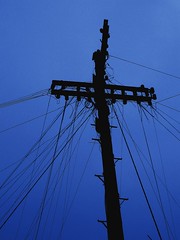A Lesson in Connections
(Cross posted at Techlearning.com)
I’ve learned a valuable lesson this week. One that shows the importance of teaching our students that the connections the web creates and the content you put on the web becomes a part of you.
Last year, I was reading a lot about digital stories in the blogosphere. I saw some good examples of how they could be used in education and decided that I should try this whole digital story thing out for myself. At about the same time, YouTube was becoming more popular and I was intrigued by the power of this new social site. So I downloaded a free trial of Camtasia and set out to create my first digital story.
I was still trying to wrap my head around Web 2.0 at the time and decided that a digital story on Web 2.0 would be a good start. So I went to Wikipedia, printed off the Web 2.0 article, did some editing to make it flow a little better, and used it for my script. I then went to the web and found pictures that matched what I was talking about and made, I thought at the time, a decent first attempt at a digital story. I created myself a YouTube account and shared it with the world.
The video had received very little attention, only being viewed just over 1000 times in the last 14 months. That is until Michael Wesch of Kansas State University decided to post this video as a video response to my Web 2.0 video. I received an e-mail when he posted it and went to have a look. Like many others, I found the video to be very well done. I linked to it on The Thinking Stick to share with others and then didn’t give it another thought…until the next morning when I checked my e-mail to find 20 new people had subscribed to my Web 2.0 video.
 In the past week and a half, I’ve seen my first attempt of a digital story go from being a little unknown corner of YouTube to having over 48,000 views. Now my poor little attempt at creating a digital story is getting knocked around with comments. Michael’s video has surpassed 1 million views, but because his video is connected to my video, I’m getting visitors as well.
In the past week and a half, I’ve seen my first attempt of a digital story go from being a little unknown corner of YouTube to having over 48,000 views. Now my poor little attempt at creating a digital story is getting knocked around with comments. Michael’s video has surpassed 1 million views, but because his video is connected to my video, I’m getting visitors as well.
We often forget about the power of connections on the web and how one good connection can propel you or your video into a whole new world. My Web 2.0 video, from what I have been told, is connected to Wikipedia (I can’t access Wikipedia in China due to the filter so I have no way to confirm this for myself).
An interesting component of this whole ‘power of connections’ has been the comments left on my video. Nobody besides the readers of this blog know the story behind my video, yet the comments are as if I should have been a real movie producer. Some are downright mean, others just nonsense, and a few are thought provoking. What ever happened to “If you don’t have anything nice to say, don’t say anything at all?â€
This whole experience has me thinking about our students and the content they produce on the web. Everything from the videos my students have on YouTube to their personal Myspace accounts. It’s a great lesson that content can lay dormant for a long time, and it only takes one connection to bring it to life. I think about our high schoolers today who are putting things on the web that today seem harmless, but tomorrow could cost them their job, or impact a family member or friend’s career. There is a lesson here that connections are constantly being formed; everything and anything you put on the web can be connected too. Our students, no matter what their grade, are creating their digital profiles, a profile that is clickable, connectable, and tells a story of who they are. Now, I wish I would have read over my script a few more times before actually posting the video, cleaned up the images, and made it a little less boring (as most of the comments state) but at the time I wasn’t thinking it was going to be viewed by 48,000 people. I was practicing; learning a new skill, and trying something new…and now the world has a hold of it.
[tags]Web 2.0, connections[/tags]
Technorati Tags: Connections, web2.0, jeffutecht
